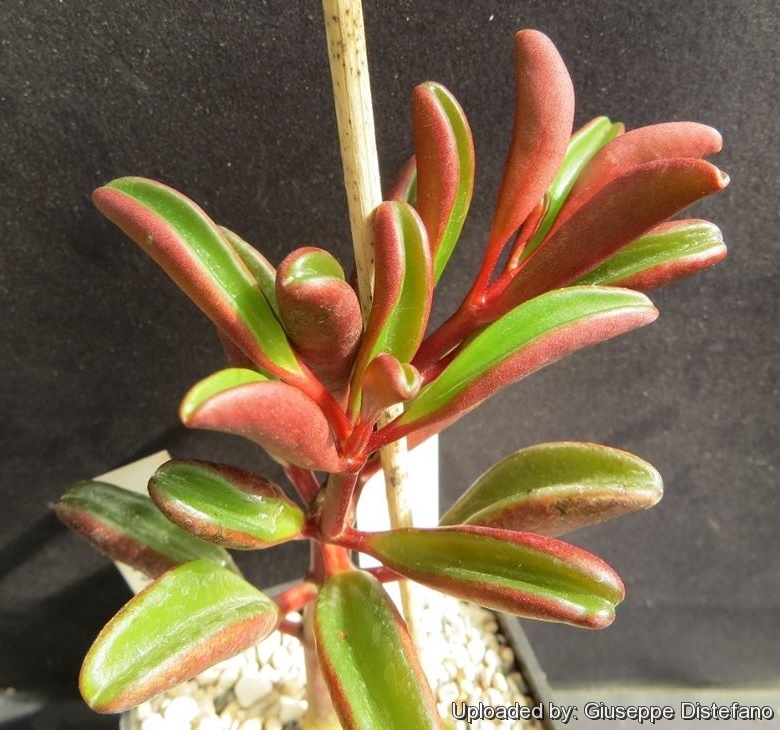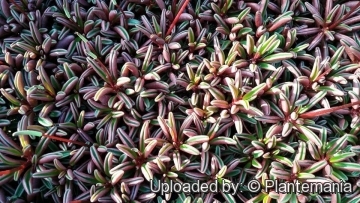




Your support is critical to our success.
Cact. Succ. J. (Los Angeles) 47(5): 205 1975.
Family: PIPERACEAE

Origin and Habitat: Peperomia graveolensSN|32151]]SN|32151]] is endemic to southern Ecuador, where it is known from two subpopulations, one around the Oña river, where the type specimen was collected in l973 and again reported for the province of Loja, the exact location is unknown (Azuay, Loja and El Oro provinces).
Altitude range: 2,000–2,500 metres above sea level.
Habitat and Ecology: Peperomia graveolensSN|32151]]SN|32151]] occurs at moderately elevated areas of dry regions of the cordillera of the Andes on cliffs, where it has cleverly adapted to its environment. Apart from habitat destruction, no specific threats are known.
Synonyms:
- Peperomia graveolens Rauh & Barthlott
ENGLISH: ruby peperomia, Ruby Glow
Description: Peperomia graveolensSN|32021]]SN|32151]] is a beautiful evergreen herb with an aboveground growth habit. It has glowing wine red stems with glossy red succulent leaves with clear green "windows" on their surfaces, much like a fat little canoes with a sunroof. The burgundy undersides are thought to assist the plant in soaking up as much sunlight as possible as it ekes out a living under the canopy. It has a mounding growth habit and reaches a height of 10-20 cm. Bloom spikes are slender pipe cleaners massed with yellowish white flowers so tiny they're nearly microscopic. Get close enough and you may detect an unpleasant odor; "graveolens" means bad smelling. Apparently this species is only known from two wild populations. All of the plants in cultivation are descendants of collections made in 1973 by some German botanists. Originally this species was referred to as a red form of Peperomia dolabnformis, but it differs in many ways besides colour.
Stems: Wine red.
Leaves: Extremely succulent, thick, wine red except on the upper side where there is a v-shaped transparent bluish-green "window" to enable photosynthesis. Mature leaves grow very thick; blunt at the tip. Nearly the entire adaxial surface of the leaves of Peperomia graveolens (and of the related Peperomia dolabriformisSN|32151]]SN|32021]]) constitute one large window. Leaves appear polished radiating a sort of oily sheen — the green topside is glossy, and the red underside is a buffed matte this gives a pleasant contrast. It seems that these plants have evolved to have leaves with red undersides as the light from the forest floors is green in spectrum, and green leaves merely reflect green light. However, red leaves can absorb and utilize some of the light to enable photosnynthesis.
Inflorescences: The terminal, simple flower raceme looks-like a long thin rat's tail, to the naked eye it appears to be a powdery lime-green 2-8 cm tall, growing singularly on long red stems that are 12-25 cm tall.
Flowers: Yellowish-white with a white margin, nearly microscopic, not showy, and smells sweetly of fresh mouse's urine.
Bibliography: Major references and further lectures
1) Steve Asbell “Plant by Numbers: 50 Houseplant Combinations to Decorate Your Space” Cool Springs Press, 01 March 2014
2) Debra Lee Baldwin “Succulents Simplified: Growing, Designing, and Crafting with 100 Easy-Care Varieties” Timber Press, 21 May 2013
3) Renato Valencia “Libro rojo de las plantas endémicas del Ecuador” Herbario QCA, Pontificia Universidad Católica del Ecuador, 01 January 2000
4) Santiana, J. & Pitman, N. 2004. Peperomia graveolens. The IUCN Red List of Threatened Species 2004: e.T45780A11011358. http://dx.doi.org/10.2305/IUCN.UK.2004.RLTS.T45780A11011358.en. Downloaded on 20 December 2015.
5) Wikipedia contributors. "Peperomia graveolens." Wikipedia, The Free Encyclopedia. Wikipedia, The Free Encyclopedia, 1 Mar. 2013. Web. 20 Dec. 2015.
6) Pepperomia graveolens at: Succulent Gardening <http://www.succulents.us/peperomgrav.html> Web. 20 Dec. 2015.
7) Jørgensen, P. M. & C. Ulloa Ulloa. 1994. “Seed plants of the high Andes of Ecuador” A checklist. AAU Rep. 34: 1–443.
8) Jørgensen, P. M. & S. León-Yánez. (eds.) 1999. “Catalogue of the vascular plants of Ecuador.” Monogr. Syst. Bot. Missouri Bot. Gard. 75: i–viii, 1–1181.
9) Rauh, W. & W. Barthlott. 1975. “Two new species of succulent Peperomias from South America.” Cact. Succ. J. (Los Angeles) 47(5): 199–208.
10) Valencia Reyes, R., N. C. A. Pitman, S. León-Yánez & P. M. Jørgensen. 2000. “Libro Rojo Pl. Endémic. Ecuador 2000” i-–v, 1–489. Herbario QCA, Pontificia Universidad Católica del Ecuador, Quito.
11) Kathryn J. Egbert, Craig E. Martin, and Thomas C. Vogelmann “The influence of epidermal windows on the light environment within the leaves of six succulents” SPECIAL ISSUE RESEARCH PAPER Journal of Experimental Botany, Vol. 59, No. 7, pp. 1863–1873, 2008 doi:10.1093/jxb/ern105 Advance Access publication 23 April, 2008 Downloaded from http://jxb.oxfordjournals.org/ by guest on December 20, 201
12) Eve Thyrum, Scott Arboretum Assistant “2014 Unusual Tropicals and Annuals Plant Sale Catalog” Scott Arboretum of Swarthmore College, Updated April 16, 2014
13) Egbert, K.J. and Martin, C.E. 2000. “Light penetration via leaf windows does not increase photosynthesis in three species of desert succulents”. Journal of Plant Physiology, 157(5): 521–525
14) “Something Smells...” April 2, 2015 <https://matt-candeias.squarespace.com/?offset=1430744764816>
15) Urs Eggli “Illustrated Handbook of Succulent Plants: Dicotyledons” Springer Science & Business Media, 2002

Peperomia graveolens Photo by: © Plantemania
The gallery now contains thousands of pictures, however it is possible to do even more. We are, of course, seeking photos of species not yet shown in the gallery but not only that, we are also looking for better pictures than those already present. Read More...
Cultivation and Propagation: Peperomia graveolens is also a really easy plant and has done well in both direct sun and bright indirect light. However, grow them in a south-facing window for the best appearance. As recently as the 1990s Peperomia graveolensSN|32151]]SN|32151]] was rare in cultivation, but since then its brilliant leaves have made it a player in the nursery marketplace. Though peperomia produce greenish- white, panicle-like flower spikes, they are grown primarily for their foliage. They are particularly attractive at the front of the bench, or on a shelf. They are not hard to grow but avoid over-watering. If you are looking for something different in a Peperomia, this is it. In warm, sub-tropical or tropical areas, these plants maybe grown outside as a ground cover.
Soil: Requires very porous soil with excellent drainage. This plant is a forest dweller and does best with a culture that gives excellent airflow and a soil that allows the water to run quickly away from the roots and not promote sodden conditions. These plants like to be a little pot bound. Outdoors, grow in well-drained soil in partial shade.
Watering: You must go rather easy on the watering, however, as it is rather sensitive to over- watering. Water moderately during summer but allow to dry moderately between waterings and sparingly during winter with water that is room temperature. Though you hear that these plants favour daily misting, it is not necessary, especially if room is not overly dry. Despite being very succulent it prefers not to dry out and to remain growing throughout the year.
Fertilization. Fertilize during the growing season with a balanced fertilizer.
Exposure: Thrives in filtered light with ample airflow. Avoid drafts. Indoors, they require bright indirect light, but do tolerate low light.
Hardiness: Not particular about temperature, but best in a moderate to warm place. Protect from frost.
Uses: Good for windowsill culture or as an accent in dish gardens.; this is not an in-ground plant unless you live in the tropics.
| Your Actions | |
|---|---|
| Back to Peperomia index | |
| Back to Piperaceae index | |
 |
Back to Succulents Encyclopedia index |
Privacy stantement - Terms and conditions - How to cite - About us - Feedback - Donate



